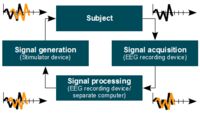Transcranial Electrical Stimulation
Project Description

Transcranial electrical stimulation (TES) covers methods for the noninvasive electrical stimulation of the brain. One differs between the transcranial direct current stimulation (tDCS) and the transcranial alternating current stimulation (tACS). For tDCS, constant current is applied between two electrodes placed at the head's surface. Depending on the direction of the current flow, the excitability of the stimulated neurons is increased or decreased. In contrast, for tACS, an alternating current is applied between the two electrodes. Amplitude, frequency and the relative phase of the current can be controlled. Thus, the rhythmic activity of the brain can be directly modified.
An innovative system for dynamic, multichannel tACS has been developed at our institute. A closed control loop with minimal latency enables the specific analysis of recorded EEG signals and the application of an adapted stimulation in real-time. Next to the evaluation in experiments with small animals for the investigation of memory processes we transfer our system to a commercial, human stimulation system.
In general, ordinary tES electrodes for human stimulation are of big size, so that large parts of the brain are stimulated. Thus, the focal stimulation of small areas in the human brain are a new challenge for us. Therefore, we develop a new approach for the placement of many small electrodes which can be separately and dynamically addressed. Due to addition and cancellation of many, small electrical fields, currents can be applied tightly focused in a small area. With the help of this procedure, the current can also be transported deeper into the brain than it is possible at the moment.

Collaborations
Within the priority program SPP 1665 „Resolving and manipulating neuronal networks in the mammalian brain“ we have collaborations with the following research partners:
- Prof. Lisa Marshall, Institut für Neuroendokrinologie, Universität zu Lübeck
- Dr. Alexey Ponomarenko, Leibniz-Institut für Molekulare Pharmakologie, CharitéUniversitätsmedizin Berlin
Publications
2019
Monosynaptic Hippocampal-Prefrontal Projections Contribute to Spatial Memory Consolidation in Mice, The Journal of Neuroscience , vol. 39, pp. 2158-18, 2019.
| DOI: | 10.1523/JNEUROSCI.2158-18.2019 |
| File: | JNEUROSCI.2158-18.2019 |
2015
An Electronically Configurable Multi-Channel tACS Device, Duesseldorf, Germany , 2015.
Effects of Oscillatory Electric Fields on EEG Coupling: Slow oscillation and Spindle Activity, Göttingen , 2015.
Modeling Electric Fields for Focal Transcranial Electrical Stimulation, Duesseldorf, Germany , 2015.
2014
Towards Closed-Loop Transcranial Alternating Current Stimulation, Munich, Germany , 2014.
2012
Sparsely optimized multi-electrode transcranial direct current stimulation, Munich , 2012.
| DOI: | 10.3389/conf.fncom.2012.55.00136 |
| File: | conf.fncom.2012.55.00136 |
Transcranial electrical stimulation accelerates sleep homeostasis in humans, New Orleans, USA , 2012.

- Research
- SonoBox: A Robotic Ultrasound System for Pediatric Forearm Fracture Diagnosis
- Robotics Laboratory (RobLab)
- OLRIM
- MIRANA
- Robotik auf der digitalen Weide
- KRIBL
- Ultrasound Guided Radiation Therapy
- Digitaler Superzwilling: Projekt TWIN-WIN
- - Finished Projects -
- High-Accuracy Head Tracking
- Neurological Modelling
- Modelling of Cardiac Motion
- Motion Compensation in Radiotherapy
- Navigation and Visualisation in Endovascular Aortic Repair (Nav EVAR)
- Autonome Elektrofahrzeuge als urbane Lieferanten
- Goal-based Open ended Autonomous Learning
- Transcranial Electrical Stimulation
- Treatment Planning
- Transcranial Magnetic Stimulation
- Navigation in Liver Surgery
- Stereotactic Micronavigation
- Surgical Microscope
- Interactive C-Arm
- OCT-based Neuro-Imaging
Ralf Bruder

Gebäude 64
,
Raum 92
ralf.bruder(at)uni-luebeck.de
+49 451 31015205
